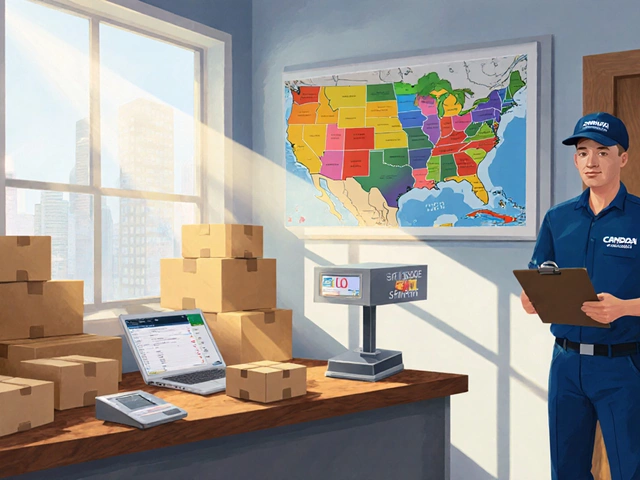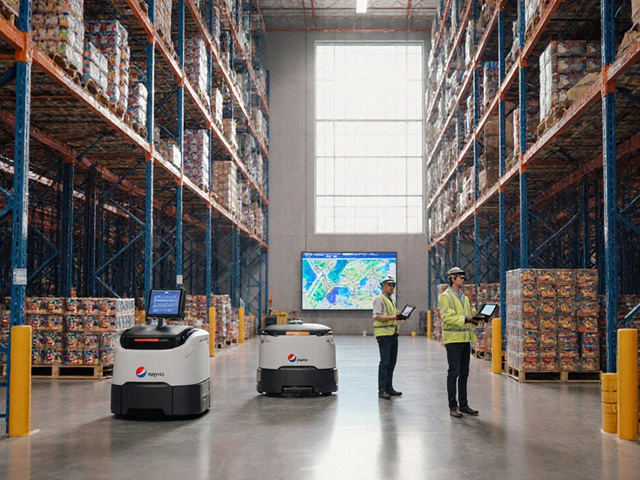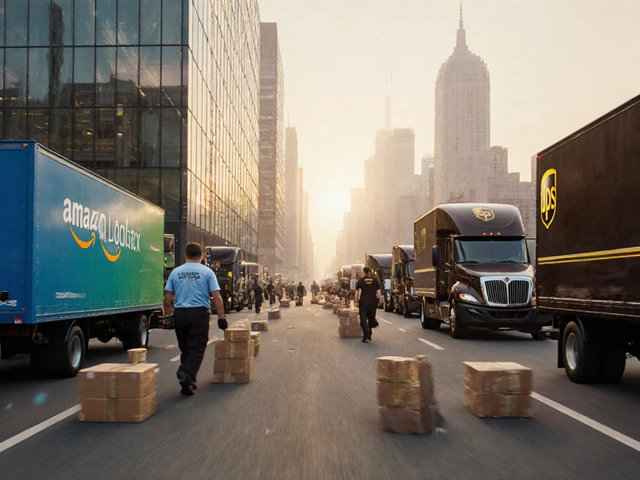The thing about e-commerce logistics—e-logistics, if you want to sound fancy—is nobody really notices it until something messes up. You know that feeling when you order something and the shipping date keeps slipping, or you get a tracking number that’s basically useless? Way more common than most brands admit.
Late deliveries or lost packages aren’t just a nuisance. They hit a business right where it hurts: repeat customers. Amazon spent billions to iron out these kinks, but most online stores don’t have that kind of cash lying around. If you’re running an e-commerce shop, every glitch can mean a bad review—and those add up fast.
Let’s get real: the biggest messes in e-logistics aren’t just about slow trucks or the odd missing box. Stuff like impossible return processes, tracking that doesn’t actually track, and surprise fees at checkout leave shoppers annoyed and way less likely to come back. Ignoring these problems doesn’t make them disappear. Want to keep customers happy? You need to dig into what’s actually broken—and fix it before the next package goes missing.
- Messy Delivery Schedules
- Returns: The Headache No One Wants
- Tracking Nightmares and Poor Visibility
- Hidden Costs and Customer Frustration
- Tech That’s Not Playing Nice
- How E-Logistics Can Shape the Future
Messy Delivery Schedules
If you’ve ever felt that promised shipping dates are more like guesses than actual plans, you’re not alone. Messy delivery schedules are one of the most frustrating issues in e logistics. A 2024 report from Convey showed that almost 60% of online shoppers said late deliveries made them hesitate to order from the same store again.
The problem usually starts with over-promising at checkout. Stores love to flash “Get it tomorrow!” on their sites, but that optimism doesn’t always match reality—especially when warehouses are swamped, storms delay routes, or carriers miss a handoff. Small shops depending on third-party couriers are hit hardest, because they’ve got way less control over the whole process.
It gets worse around holidays or when there’s a big sale. Black Friday 2023 left plenty of people waiting days past the expected arrival date because carriers and warehouses simply got overwhelmed. This can lead to angry emails, refund fights, or even a total loss of customer trust.
- Track orders with real-time updates so customers aren’t left guessing. Tools like AfterShip or ShipStation can help.
- Never promise shipping speeds you can’t guarantee. Be upfront if an order might take 5-7 days.
- Work with carriers that actually deliver on their word. If a partner keeps missing deadlines, it pays to find someone else.
- Give buyers some control—offering choices at checkout for standard, express, or flexible delivery windows can keep complaints down.
In the end, nailing delivery schedules can be the difference between a quick sale and a customer who swears off your store for good. Small improvements here can pay off big in repeat business and fewer angry calls to support.
Returns: The Headache No One Wants
Let’s be honest: nobody enjoys dealing with returns, not shoppers and definitely not sellers. In the wild world of e logistics, returns are a major pain point. Here’s the catch—research shows that about 30% of everything bought online ends up getting sent back, but only around 9% in traditional brick-and-mortar stores. That’s a huge gap, and it clogs up the whole system.
Why is it such a mess? First, half the time, return policies read like a phone contract. You get packaging rules, deadlines, restocking fees—and tracking a return can feel like throwing something into a black hole. Plenty of people just give up, especially if they have to pay shipping or jump through weird hoops.
Retailers get a double whammy. Not only do they lose out on the original sale, but handling returns means extra costs for reps, warehouses, and sometimes dealing with products they can’t re-sell. Returns aren’t just “put it back on the shelf.” Items can come back damaged or outdated, and restocking costs add up fast. Some companies even scrap or destroy returned products because it’s cheaper than reselling them.
So what actually works? Simple, flexible return policies help a ton. Amazon and Zappos are famous for being no-hassle, and that’s one reason people stick with them. If you’re running a store, here are some ways to make returns less of a headache:
- Write your return policy in plain language, not legalese.
- Let shoppers print return shipping labels at home.
- Offer drop-off options (think UPS stores or locker pickups), not just shipping back from home.
- Send automatic updates when returns arrive and refunds process.
- Don’t bury fees—be clear if there are any costs.
Treat returns like customer service, not a punishment. Fast, clear, and fair returns make people trust your brand—even if the first order didn’t work out. It’s not glamorous, but it pays off in repeat business and way fewer headaches all around.
Tracking Nightmares and Poor Visibility
Nothing tanks customer trust faster than feeling left in the dark about an online order’s location. And yet, bad tracking is everywhere. Some stores send an email with a tracking link that never updates. Others share details only after a package is already out for delivery—if you’re lucky.
Here’s a real number: According to a 2023 survey by MetaPack, nearly 70% of shoppers said poor parcel visibility made them think twice before buying again from the same store. That’s a big chunk of lost loyalty. E-commerce sellers often rely on third-party couriers who may not have real-time updates, or they cobble together several different tracking systems that don’t sync up. This mess leaves both customers and support reps stuck without answers.
The ripple effects are brutal. When buyers can’t tell if their package is actually moving—or why it’s stuck in a random warehouse—they start flooding support teams with angry emails. If the brand’s answer is simply, "We don’t know either," you’ve got a recipe for bad reviews and canceled future orders.
So what fixes work? Here’s how top stores handle this nightmare:
- Pick a shipping partner with real-time tracking that actually works, not just a ‘shipped’ email and blank wait time.
- Centralize tracking info—make one dashboard or one email thread where people can see every update.
- Add mobile alerts and push notifications so shoppers aren’t guessing where their package is.
If you run a small shop, using an e-commerce platform that syncs nicely with popular couriers is a smart move. Even big players like Shopify and WooCommerce have spent millions making it easier to integrate live tracking that customers love. Don’t let tracking be the weak link in your e logistics game. Nail this, and you’ll have way fewer headaches—for you and your buyers.

Hidden Costs and Customer Frustration
Nothing gets shoppers more fired up than spotting a sweet deal, adding stuff to their cart, and suddenly watching the price jump right before checkout. This happens all the time in e logistics because of surprise shipping charges, odd handling fees, or mystery taxes. Want a fast way to lose trust? Add $15 in delivery fees after someone’s entered their address.
According to a 2023 report by Baymard Institute, nearly 48% of US online shoppers said unexpected extra costs are the top reason they abandon their purchases. That’s nearly half of all abandoned carts—just because businesses hid the real price until the last minute.
“If you want to keep your conversion rates healthy, be straight with costs up front. Shoppers will almost always bail once they feel tricked by hidden charges.”
— Baymard Institute E-Commerce Checkout Study, 2023
It’s not just shipping. Some sites sneak in special packaging fees or vague ‘service’ charges. Others don’t show import taxes on international orders, so customers get a nasty surprise from the mail carrier. The trust gets busted pretty quickly.
Here are the top hidden costs that drive people nuts:
- Extra shipping/handling at checkout
- Duties or import taxes never mentioned up front
- Rush order or weekend delivery fees
- Return shipping that only shows up if something’s wrong
If you want an easy fix, just show all costs before the final click. Some online stores even use shipping calculators or cost estimators you can try before checkout.
This table shows why being up front about costs matters to customers, based on a survey from late 2024:
| Reason for Cart Abandonment | Percentage of Shoppers |
|---|---|
| Hidden shipping or fees | 48% |
| Slow delivery | 22% |
| Unclear return policies | 17% |
| Payment issues | 9% |
For any online business, the take-home message is simple: show costs early, make fees clear, and nobody feels tricked. It won’t just avoid angry emails—you’ll actually sell more, too.
Tech That’s Not Playing Nice
Here’s something that trips up loads of online businesses: all their slick software tools just don’t talk to each other. Imagine—your inventory app says you’ve got five pairs of shoes in stock, but your website, running on another system, thinks you sold out hours ago. One of the top e logistics headaches is systems that don’t sync up smoothly.
This mess pops up everywhere. Warehouse robots, order management platforms, customer service dashboards, delivery apps—everyone’s using different tech. And each company in the supply chain often uses their own home-brewed solutions. The result? Delayed orders, inventory mistakes, and endless time wasted fixing issues by hand.
Take a look at this data—the cost of disconnected tech isn’t just theoretical:
| Issue | How Often It Causes Delays (2024) | Extra Cost Per Year (average, mid-sized e-comm) |
|---|---|---|
| Inventory not syncing | 67% | $115,000 |
| Order tracking errors | 41% | $59,000 |
| Manual data entry | 28% | $34,000 |
One real pain? Manual workarounds. If your tech doesn’t connect automatically, staff waste hours re-entering orders or hunting for lost shipments. And yep, more manual work means more mistakes: wrong addresses, duplicate shipments, and some seriously annoyed customers.
So what actually helps? Here’s what companies looking to untangle their e-logistics tech usually do:
- Pick logistics platforms with open APIs, so they can plug into different tools without drama.
- Use cloud-based inventory and order management—the kind that updates in real time across every channel.
- Automate the boring stuff wherever possible, like tracking updates and label printing.
- Push for regular tests—tech breaks when nobody’s watching.
It’s not always cheap to overhaul your tech stack. But ignoring tech problems in e-logistics is like building your house on sand. Fixing these issues pays off long-term with happier buyers and way fewer costly slip-ups.
How E-Logistics Can Shape the Future
E-logistics isn’t just about getting your package from A to B. It’s quickly becoming the backbone of the entire digital shopping world. What’s cool is how fast new tech is coming in to solve old problems. Let’s check out a few ways this space is about to change everything—sometimes faster than we expect.
One big area to watch: automation in warehouses. Robots and conveyor systems cut down packing times and errors. For example, Ocado in the UK runs warehouses where robots pick groceries at lightning speed—up to 65,000 orders a week from just one site. That’s metal arms and AI doing the heavy lifting, not armies of human workers scrambling for products.
Then there’s the last-mile delivery problem, which is really just code for "my package is stuck somewhere in town, probably in a van." Drones and autonomous vehicles are finally moving past the hype. Alphabet's Wing drones are already dropping off small items in parts of Texas and Australia—sometimes within 10 minutes of clicking buy.
Here’s where it gets even more game-changing: real-time tracking with smart sensors and AI. You’re not just getting a "shipped" email anymore. Sensors can track location, temperature (huge for food or medicine), and even package tampering. More transparency for shoppers, less guesswork for businesses.
But it’s not just about shiny new stuff. More companies are leaning into green logistics—think electric vans, route optimization, reusable packaging. Here’s a quick look at some numbers:
| Trend | Impact/Stat |
|---|---|
| Warehouse Automation | 40% reduction in packing time (McKinsey, 2023) |
| Drones/Robots | 20-minute average delivery window in test markets (Wing, 2024) |
| Green Shipping | 60% of retailers plan to invest in electric vehicles by 2026 (DHL study) |
| Real-Time Tracking | 92% of customers say real-time updates boost trust (MetaPack survey, 2023) |
So what does all this mean if you run or shop at an online store? Be ready for faster, smarter, more reliable—and greener—e logistics from here on out. The brands that invest early will keep customers happy and probably leave slower competitors behind.
- Keep an eye out for new delivery options—sometimes drone drop-offs really are faster.
- If you run an online shop, upgrading your warehouse tech pays off, even if you start small.
- Don’t ignore green options. Customers notice, and it can save money long term.
- Let customers track everything in real time, not just when “the order has shipped.”
No one’s got a crystal ball, but one thing’s crystal clear: e-logistics is shaking up how and how fast we all shop online.





